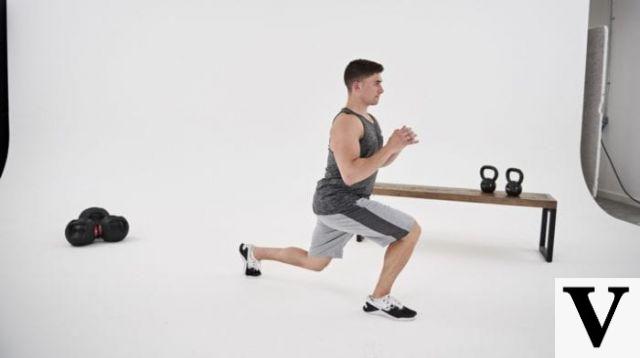Lunges are an excellent exercise that allows you to train the muscles of the lower limbs in a unilateral way. This is important as the lower limb muscles are subject to work throughout the day.
This means that any postural imbalance or habit of maintaining unbalanced positions leads to a diversified development between the two limbs. The more this difference is accentuated and the more one tends to use the dominant limb, a vicious circle is therefore triggered that undermines a physiological postural structure.
The lower limbs are the link between the rest of the body and the ground and therefore a downstream modification leads to a necessary upstream compensation. In particular, the joints of the pelvis and spinal column are directly affected. If an axial load, such as a squat or deadlift, is added to this poor posture, you risk serious injury.
Unilateral exercises therefore make it possible to bridge this development gap and prevent unwanted injuries. moreover, the unilateral work increases the intervention by the stabilizing muscles in the pelvis. Lunges are therefore an excellent exercise that should be part of any training program.
There are many variations for lunges, in this article we will discuss in particular between forward lunges and back lunges

Differences
It is possible to draw general lines on the execution of these two variants but it is necessary to specify that each subject performs this exercise in a particular way.
The position of the trunk and the width of the step can also reverse the muscular work outlined. Forward lunges involve more work from the posterior kinetic chain.
This is due to the weight of the body and the dumbbells / barbell which tends to push the torso forward. To resist this push, the muscles that prevent excessive forward bending must necessarily work harder.
Furthermore, since the movement is forward, one tends to follow the direction with the rest of the body and therefore to tilt the pelvis slightly forward. This stretches the extensor muscles of the pelvis which are placed in the posterior kinetic chain.
In general, if you are doing forward lunges, it is better to do the walking lunges than the stationary ones. This statement is based on the fact that if you lunge forward and then return to the starting position you do not have full control of the movement and also the stress on the knee of the stationary limb is high.
If you step forward to go back, you need to push back with the leg that has moved. This movement is not very stable and therefore it is not a good idea to overload with additional weight.
Furthermore, in this transition phase the work of the muscles is almost nil as only the initial thrust work is exploited. The only work is on the part of the leg that has remained fixed
to the ground which must push forward to bring the body back. This push is done, however, while only the front part of the foot touches the ground (so it unloads the weight) and the knee is definitely in a risky position.
The back lunges allow you to keep the torso more vertical and to recruit more muscles of the anterior kinetic chain. The work is mainly carried out by the leg that is fixed to the ground. This reduces the stress on the knee.
In walking lunges, in fact, the work is carried out by the moving leg but this must impact with the ground before the knee flexes. This involves an important stress that is not present in the back lunge variant.
In the return phase, since the working leg remains fixed with the ground, the movement is much more controlled and the stress on the knee is reduced. This makes back lunges a more joint-friendly exercise and more prone to overload.
It is also possible to perform back lunges on a raised surface by increasing the ROM of the exercise and without compromising the technique.
Conclusion
Back lunges are a superior alternative to forward lunges. This conclusion is made both on the basis of stress on the joints and the work of the affected muscles.
The forward lunges while walking are a good exercise that allows you to work the posterior kinetic chain more and have an exercise in constant movement but present greater joint stress.


























